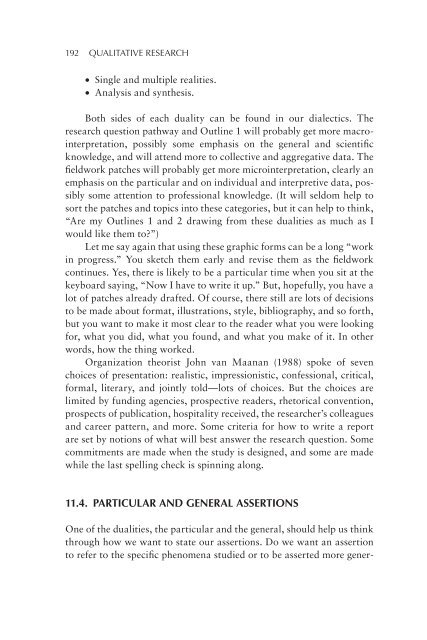How Things Work - Doha Academy of Tertiary Studies
How Things Work - Doha Academy of Tertiary Studies
How Things Work - Doha Academy of Tertiary Studies
You also want an ePaper? Increase the reach of your titles
YUMPU automatically turns print PDFs into web optimized ePapers that Google loves.
192 QUaLItatIVe ReSeaRCH<br />
••<br />
Single and multiple realities.<br />
••<br />
Analysis and synthesis.<br />
Both sides <strong>of</strong> each duality can be found in our dialectics. The<br />
research question pathway and Outline 1 will probably get more macrointerpretation,<br />
possibly some emphasis on the general and scientific<br />
knowledge, and will attend more to collective and aggregative data. The<br />
fieldwork patches will probably get more microinterpretation, clearly an<br />
emphasis on the particular and on individual and interpretive data, possibly<br />
some attention to pr<strong>of</strong>essional knowledge. (It will seldom help to<br />
sort the patches and topics into these categories, but it can help to think,<br />
“Are my Outlines 1 and 2 drawing from these dualities as much as I<br />
would like them to?”)<br />
Let me say again that using these graphic forms can be a long “work<br />
in progress.” You sketch them early and revise them as the fieldwork<br />
continues. Yes, there is likely to be a particular time when you sit at the<br />
keyboard saying, “Now I have to write it up.” But, hopefully, you have a<br />
lot <strong>of</strong> patches already drafted. Of course, there still are lots <strong>of</strong> decisions<br />
to be made about format, illustrations, style, bibliography, and so forth,<br />
but you want to make it most clear to the reader what you were looking<br />
for, what you did, what you found, and what you make <strong>of</strong> it. In other<br />
words, how the thing worked.<br />
Organization theorist John van Maanan (1988) spoke <strong>of</strong> seven<br />
choices <strong>of</strong> presentation: realistic, impressionistic, confessional, critical,<br />
formal, literary, and jointly told—lots <strong>of</strong> choices. But the choices are<br />
limited by funding agencies, prospective readers, rhetorical convention,<br />
prospects <strong>of</strong> publication, hospitality received, the researcher’s colleagues<br />
and career pattern, and more. Some criteria for how to write a report<br />
are set by notions <strong>of</strong> what will best answer the research question. Some<br />
commitments are made when the study is designed, and some are made<br />
while the last spelling check is spinning along.<br />
11.4. PaRticulaR aND GeNeRal asseRtiONs<br />
One <strong>of</strong> the dualities, the particular and the general, should help us think<br />
through how we want to state our assertions. Do we want an assertion<br />
to refer to the specific phenomena studied or to be asserted more gener-

















